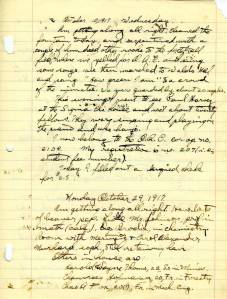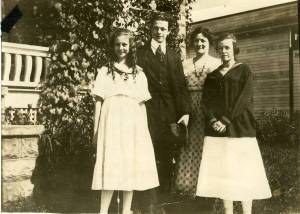
Pastel drawing of a Tantalum Halide cluster ion. 1964.
[Part 4 of 4. Questions about Roger Hayward may be directed to the authors of this text — Dr. J.R. Kramer, Miriam Kramer and John Benjamin — at jkramer2[at]cogeco.ca]
Linus Pauling may have learned about Roger Hayward and his “drafting” talent in the early 1930s. Hayward had designed several new architectural structures in the LA area (the Doheny Library and the Los Angeles Stock Exchange, for example) many of which had been prominently displayed in the local papers.
With the onset of the Depression, Hayward was looking for work. At the same time, Pauling was going “great guns” in determining new molecular structures, and was likewise building models for use in classes at Caltech. Hayward possessed the ability to visualize these structures in three dimensions, to illustrate these structures in a 3-D perspective and to make models of the structures.
Initially Pauling may have viewed Roger only as a “draftsman”, albeit a particularly talented one. Despite their proximity, Pauling and Hayward communicated mostly by letter. One reason for this was that Pauling was always busy or traveling, thus making face-to-face meetings difficult to arrange. Hayward, on occasion, would go to Caltech to pick up sketches or notes, but otherwise the collaborators did not often meet in person.
Fundamentally, the two men were consumed with rather different lifestyles: Pauling was usually in a rush and often did not have enough time to follow all of his pursuits. On the other hand, Hayward, at least upon his departure from the Lunden partnership, had time to do as he wished, and to ponder the many diverse subjects that interested him.
An Evolving Relationship
A series of letters changed the somewhat distant collaborative relationship from that of draftsman-scientist to, in Pauling’s estimation, that scientist-scientist. After a series of many requests for Hayward’s time, on July 19, 1951 Pauling wrote:
“Could you, during the next few days, make some drawings? We need to get a paper off for publication immediately, because I have learned that someone else (a Swede) is doing some closely similar work, and I think that we might as well publish our results obtained so far….I would like to have drawings made of the structure Na2Cd11 closely similar to what you have already made for me in pastel. There is, however, one difference, which I shall describe below — this involves an interchange of the six larger atoms and six of the smaller atoms…”
On July 27 Hayward replied:
“I believe that a review of the enclosed sketch for the revised figure E discloses that the octahedron cannot be placed where required if the radii and spacings are consistent with my interpretation of your directions. Furthermore if all the triacontahedra are shown completely surrounding the octahedron, the figure will be unintelligible….I will reiterate that I do these figures for the pleasure involved. Such a catalogue of criticisms of drawings which you requested me to do in a hurry is not pleasant.”
Pauling responded on August 2:
“I return the sketches on the Na2Cd11 structure with my apology. I have just discovered, a couple of days ago while going over calculations with Dr. Ewing, that I had placed the large atoms in the wrong positions in the rhomb….I think that this will take care of the steric difficulty that you have pointed out….”
This exchange changed Pauling’s attitude towards Hayward in that he now had complete confidence in Roger’s abilities properly illustrate molecules and, indeed, to act as a check on Pauling’s calculations. Furthermore, Pauling considered Hayward to be a scientific colleague, as evidenced by the publication of “The Structure of Protein Molecules,” a 1954 Scientific American paper in which, for the first time, Hayward is included as a co-author.
The Pauling-Hayward relationship further evolved when a German magazine raised Pauling’s ire by copying the Scientific American article without permission, altered its illustrations and deleting Hayward as a co-author. The above exchange is also suggestive of the difference in the personalities of the two men. Pauling was a highly-driven person working in the competitive field of molecular structure determination. Hayward, on the other hand, was motivated primarily by his passion for artistic merit and out of curiosity.
Roger, of course, required that his art be correct, especially in matters technical. But for Roger a large part of the enjoyment that he derived from his work emanated out of the association and discussions that the work afforded with intellects such as Linus Pauling. Roger, in fact, did not even necessarily expect monetary compensation for his labor. For example, in a letter to Pauling, dated January 9, 1953, Hayward writes:
“Enclosed herewith is the Institute’s check no. 93369 which I prefer not to accept…. [and] I wish my designation as Research Assistant of the Chemistry department to be discontinued at the earliest possible moment. I shall call myself a friend of the Chemistry Department and will enjoy continuing to assist you and the department in an advisory capacity which will include the making of drawings when the occasions arise.”
The Architecture of Molecules
Perhaps the climax of the Pauling-Hayward relationship — and, indeed, a happy one — was the creation of their best-seller, The Architecture of Molecules, published in 1964.
The development of this book, initially titled Molecular Architecture, can be credited to the visions of William Freeman, Stan Schaefer, Harry Marks, Linus Pauling and Roger Hayward. By 1964, Roger had completed a series of illustrations for Pauling’s College Chemistry and the Pauling-Hayward team had also worked well together on a number of professional papers. The time seemed right to collate all of this information into an artistic/scientific book written for the general public.
On March 12, Hayward became the last party to sign the publishing agreement. (It may have been a bit fortuitous that on March 26, Scientific American and W.H. Freeman announced the merger of their operations.) On March 31, Pauling, Hayward and Harry Marks met at Roger’s home to conceptualize the design and workflow for the book. As Roger noted in a letter to Stanley Schaefer, dated March 31, 1964, “Linus Pauling plans to write from the illustrations and so it is my move and I shall have to restrain a little lest I over-do.”

Pastel drawing of Camphor. 1964.

Pastel drawing of Ethylene. 1964.

Pastel drawing of Hexamethylenetertramine. 1964.
The bulk of the communications regarding this project, exchanged mostly between Harry Mark and Roger Hayward, reveal an air of excitement and fun. Roger planned to draw with pastels, and described in great detail the paper, textures, layouts and, most importantly, colors that he hoped to feature. A four-color press was a must for this publication, as the drawings would not include a white margin, thus lending more depth to the molecular structures. Use of pastels also afforded a certain amount of needed haziness to the diagrams, as the precise bonding of atoms was not entirely clear. (In this Roger made great use of the tutorials in atomic physics he had previously received from R.M.Langer).
The myriad details that Roger forwards include specific colors to be used and their Munsell color notations. Lighting effects for each diagram were discussed at length between Roger and Harry Mark. When a diagram was complete, Pauling would review it, approve it, and then write an accompanying text. The communications regarding production end with a September 21, 1964 letter in Pauling confirms the change in title of the book to The Architecture of Molecules and notes his concern with publication delays, hoping for Christmas sales and revenue.

Annotated pencil sketch of the structure of ice. 1964.

Pastel drawing of Methane. 1964.

Pastel drawing of Sodium Chloride. 1964.
A few notes regarding the book: On January 19, 1965, Roger Hayward wrote to Harry Marks requesting return of the color slides of the plates. To date these slides have not been found. The book itself received high praise as a work of art. The emphasis in every review is on the drawings, perhaps because this was among the first publications where art and science are so thoroughly blended. The book has been translated into Spanish, German and Japanese among other languages.
This was also the last major joint publication between Linus Pauling and Roger Hayward. The collaborators did, however, remain professional friends as suggested by the text of Pauling’s lecture at Berkeley in 1976, in which he refers to Roger Hayward as a scientist, and a 1976 letter from Hayward to his cousin Marjorie Widdop, in which Roger states that he and Pauling have been friends and have worked together for over 40 years.

Greeting to Linus Pauling on his 75th Birthday
A Final Word
Roger worked “for the fun of it”. He was a curious individual and was satisfied when he discovered or exhibited something new. In this regard he was a true dilettante, but a brilliant one. To him art and science were both means for reaching reality, a perspective which he conveys in an October 1941 letter to Sam Lunden:
“As with all narratives, it should be possible to smoke out a moral or two. These must have to be in the form of deductions from my own experience. It has been stated that architecture is a gentleman’s profession, and I presume that a gentleman is one who is able to subsist without visible means of support. Certainly during the depression, this statement was true. Since I have no invisible supporting mechanism, I solved the problem of developing a good healthy, time-consuming, interest-absorbing hobby. I now find to my pleasure that my hobby can not only feed itself, but me as well.”
For more on Roger Hayward please see his Key Participants page on the website Linus Pauling and the Nature of the Chemical Bond: A Documentary History, or click here.
Filed under: Colleagues of Pauling, Documentary History Websites, Featured Documents, Nature of the Chemical Bond, Roger Hayward | Tagged: featured document, Linus Pauling, Roger Hayward, The Architecture of Molecules | 3 Comments »







































